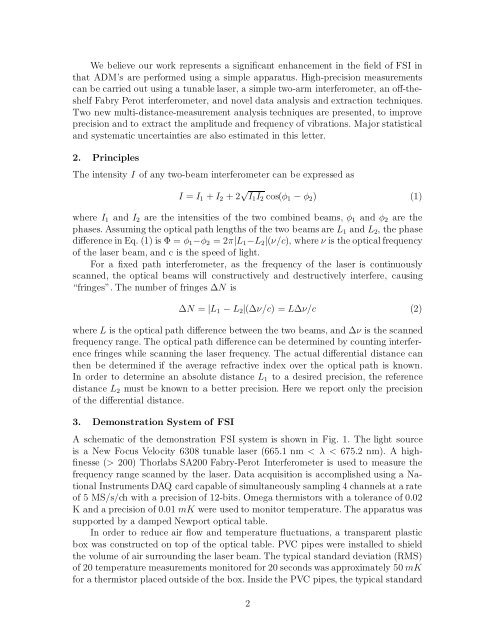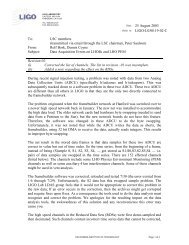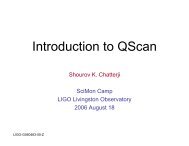High-precision Absolute Distance Measurement using Frequency ...
High-precision Absolute Distance Measurement using Frequency ...
High-precision Absolute Distance Measurement using Frequency ...
Create successful ePaper yourself
Turn your PDF publications into a flip-book with our unique Google optimized e-Paper software.
We believe our work represents a significant enhancement in the field of FSI in<br />
that ADM’s are performed <strong>using</strong> a simple apparatus. <strong>High</strong>-<strong>precision</strong> measurements<br />
can be carried out <strong>using</strong> a tunable laser, a simple two-arm interferometer, an off-theshelf<br />
Fabry Perot interferometer, and novel data analysis and extraction techniques.<br />
Two new multi-distance-measurement analysis techniques are presented, to improve<br />
<strong>precision</strong> and to extract the amplitude and frequency of vibrations. Major statistical<br />
and systematic uncertainties are also estimated in this letter.<br />
2. Principles<br />
The intensity I of any two-beam interferometer can be expressed as<br />
I = I 1 + I 2 + 2 √ I 1 I 2 cos(φ 1 − φ 2 ) (1)<br />
where I 1 and I 2 are the intensities of the two combined beams, φ 1 and φ 2 are the<br />
phases. Assuming the optical path lengths of the two beams are L 1 and L 2 , the phase<br />
difference in Eq. (1) is Φ = φ 1 −φ 2 = 2π|L 1 −L 2 |(ν/c), where ν is the optical frequency<br />
of the laser beam, and c is the speed of light.<br />
For a fixed path interferometer, as the frequency of the laser is continuously<br />
scanned, the optical beams will constructively and destructively interfere, ca<strong>using</strong><br />
“fringes”. The number of fringes ∆N is<br />
∆N = |L 1 − L 2 |(∆ν/c) = L∆ν/c (2)<br />
where L is the optical path difference between the two beams, and ∆ν is the scanned<br />
frequency range. The optical path difference can be determined by counting interference<br />
fringes while scanning the laser frequency. The actual differential distance can<br />
then be determined if the average refractive index over the optical path is known.<br />
In order to determine an absolute distance L 1 to a desired <strong>precision</strong>, the reference<br />
distance L 2 must be known to a better <strong>precision</strong>. Here we report only the <strong>precision</strong><br />
of the differential distance.<br />
3. Demonstration System of FSI<br />
A schematic of the demonstration FSI system is shown in Fig. 1. The light source<br />
is a New Focus Velocity 6308 tunable laser (665.1 nm < λ < 675.2 nm). A highfinesse<br />
(> 200) Thorlabs SA200 Fabry-Perot Interferometer is used to measure the<br />
frequency range scanned by the laser. Data acquisition is accomplished <strong>using</strong> a National<br />
Instruments DAQ card capable of simultaneously sampling 4 channels at a rate<br />
of 5 MS/s/ch with a <strong>precision</strong> of 12-bits. Omega thermistors with a tolerance of 0.02<br />
K and a <strong>precision</strong> of 0.01 mK were used to monitor temperature. The apparatus was<br />
supported by a damped Newport optical table.<br />
In order to reduce air flow and temperature fluctuations, a transparent plastic<br />
box was constructed on top of the optical table. PVC pipes were installed to shield<br />
the volume of air surrounding the laser beam. The typical standard deviation (RMS)<br />
of 20 temperature measurements monitored for 20 seconds was approximately 50 mK<br />
for a thermistor placed outside of the box. Inside the PVC pipes, the typical standard<br />
2







